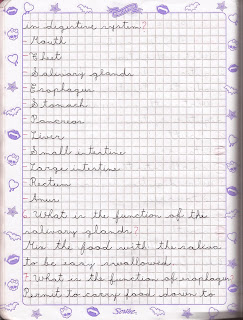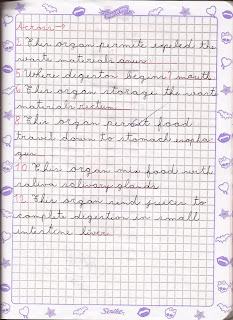Solve this workshop in your notebook:
1. Answer the following questions:
a. What is autothrophic nutrition? Give
1 picture as example
b. What is heterothrophic nutrition? Give
1 picture as example
c. What is interaction? Give 1 picture
as example
d. What is asexual reproduction ? Give 1
picture as example
e. What is sexual reproduction? Give 1 picture
as example
2. Name 10 organs of digestive system
3.Complete the activity
a. List two functions your teeth do when you chew?
__________________________________________________________________________
__________________________________________________________
b. What are the stages of the
digestion?
________________________________________________________________________________________________________________________________________________________________________________________________________________________________
c.
What is the function of the digestive system?
d. What is the function of the
stomach, mouth, small intestine, and large intestine?
Stomach: ___________________________________________________________________________________________________________________________________________
Mouth:
___________________________________________________________________________________________________________________________________________
Small intestine:
____________________________________________________________________________________________________________________________________________
Large intestine:
_______________________________________________________________________________________________________________________________________
4. Answer the questions according to the reading
5. Give a short explanation about the kind of respiration and draw an animal of each one
- Cutaneous repiration:
- Pulmonary respiration:
- Tracheal respiration:
- Branquial respiration:
Mitochondria are the powerhouses of the cell because
they “burn” or break the chemical bonds of glucose to release energy to do work
in a cell. Remember that this energy
originally came from the sun and was stored in chemical bonds by plants during
photosynthesis. Glucose and other carbohydrates made by plants
during photosynthesis are broken down by the process of aerobic cellular
respiration (requires oxygen) in the mitochondria of the cell. This releases energy (ATP) for the
cell. The more active a cell
(such as a muscle cell), the more mitochondria it will have. The mitochondria are bout the size of a
bacterial cell and are often peanut-shaped.
Mitochondria have their own DNA and a double membrane like
the nucleus and chloroplast. The outer
membrane is smooth, while the inner membrane is convoluted into
folds called cristae in order to increase the surface area.
1. Why
are mitochondria called the powerhouse of the cell?
2. What
cell process occurs in the mitochondria?
3. Why
do some cells have MORE mitochondria? Give
an example.
4. What
simple sugar is broken down in the mitochondria?
5. Where
does the energy in glucose come from ORIGINALLY?
6. Where
is this energy stored in glucose?
7. Why
is cellular respiration an aerobic process?
8. Name
two other organelles besides the mitochondria that contain DNA and have a
double membrane.
9. Describe
the outer membrane of the mitochondria.
- Cutaneous repiration:
- Pulmonary respiration:
- Tracheal respiration:
- Branquial respiration:
Good luck!!!
Don´t forget to prepare well your bimestral exam.
See you next week.
bye bye
Don´t forget to prepare well your bimestral exam.
See you next week.
bye bye




















